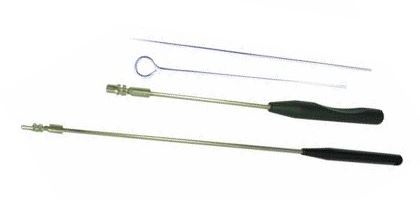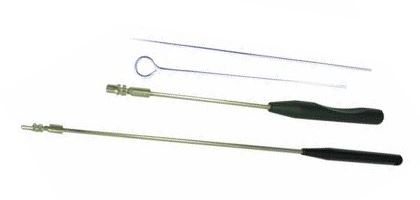HANDLE for Pasteur loop
Valid Article
PASTEUR HANDLE, LOOP and INOCULATION NEEDLE
Definition
An inoculation loop is a simple tool used to gather and transfer microscopic organisms from a culture or broth plate. The small loop removes a consistent amount of inoculum by using surface tension.
An inoculation needle is used for transfer and repicking of bacterial colonies and for the inoculation of Kligler Hajna media.
Both are used with an Pasteur handle.
Synonym
Microloop Pasteur, Wire loop, Culture or Culture media inoculating, streaker.
Specifications
Technical specifications
HANDLE
- Stainless steel or aluminium
- Length: ± 285 mm
- Hollow end (0.3 - 0.6 mm) to insert the wire of the loop or the inoculation needle
LOOP
- Nickel-chromium
- Length of the wire: > 45 mm
- Ø of the wire: 0.6 mm
- Ø of the loop: +/- 5 mm
- Volume: 10µl
INOCULATION NEEDLE
- Stainless steel
- Length of the wire: > 35 mm
Instructions for use
The inoculation loop and inoculation needle are flame-sterilized before and after each use to eliminate cross-contamination between cultures. The loop and needle must be cooled after sterilization to avoid destroying the organisms.
In TB laboratory, the loop is used to take a sample of sputum and spread it on a slide for detecting the Koch's bacillus.
Possible alternative: single use plastic loop (see related articles below).
MSF requirements
Some tests in bacteriology laboratories, require the use of a calibrated loop with a specific volume. This is not the case for all tests, for example smears on slides.
Avoid wire from a reel (loop more difficult to make - no precise volume).
Alternative: loop fastened to the handle, platinum model.
Some suppliers sell handles and loops/needles separately. Check for compatibility.





![[ELABMILP1L-] (Pasteur handle) INOCULATION NEEDLE, inox](/web/image/product.template/570985/image_256/%5BELABMILP1L-%5D%20%28Pasteur%20handle%29%20INOCULATION%20NEEDLE%2C%20inox?unique=4c5456a)
![[ELABMILP2--] INOCULATION LOOP, plastic, 10 µl, sterile, s.u.](/web/image/product.template/570991/image_256/%5BELABMILP2--%5D%20INOCULATION%20LOOP%2C%20plastic%2C%2010%20%C2%B5l%2C%20sterile%2C%20s.u.?unique=d9d8c14)
![[ELABMILP2L-] (microloop, Pasteur) LOOP, nickel chromium, 10 µl](/web/image/product.template/569835/image_256/%5BELABMILP2L-%5D%20%28microloop%2C%20Pasteur%29%20LOOP%2C%20nickel%20chromium%2C%2010%20%C2%B5l?unique=b26010c)
![[ELABMILP3--] INOCULATION LOOP, plastic, 1 µl, sterile, s.u.](/web/image/product.template/569053/image_256/%5BELABMILP3--%5D%20INOCULATION%20LOOP%2C%20plastic%2C%201%20%C2%B5l%2C%20sterile%2C%20s.u.?unique=e9825d0)
![[KMEDMLAB113] (laboratory mod) TUBERCULOSIS EQUIPMENT microscopy 1000tests](/web/image/product.template/573144/image_256/%5BKMEDMLAB113%5D%20%28laboratory%20mod%29%20TUBERCULOSIS%20EQUIPMENT%20microscopy%201000tests?unique=13897b6)